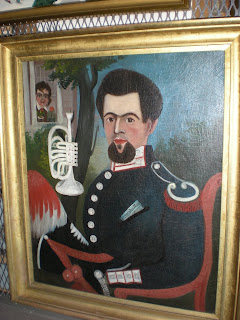 Eric Selch loved American music. He was the founding father of the American Musical Instrument Socitey and the publisher and editor of the monthly classical music magazine Ovation. He even produced a Broadway musical, Play Me a Country Song, in the early 1980s.
Eric Selch loved American music. He was the founding father of the American Musical Instrument Socitey and the publisher and editor of the monthly classical music magazine Ovation. He even produced a Broadway musical, Play Me a Country Song, in the early 1980s.Eric also changed the way people thought about the history of music. Such an ethereal art form left little in the way of a tangible history in the eyes of most scholars of the subject. Not so for Eric Selch. He pioneered the study of the material evidence of American music by collecting antique American musical instruments, paper ephemera, rare books, and artworks depicting musical subjects. He organized museum exhibitions on American music as early as the late 1950s.
Eric and his wife Pat spent a good part of their lives in New York, but he had a passion for upstate New York. They bought a grand old mansion outside of Sharon Springs and renovated it into a remarkable country estate. Lucky guests and visitors were treated to an incredible collection housed in a spacious building that reflected the rural roots of our musical traditions. Eric and Pat were gracious and generous hosts, and lent items from their collection freely to museums that needed them for exhibitions and programs, including ours. After Eric’s passing in 2002 the entire collection was given to Oberlin College, to accompany a renowned academic program in the study of American music.
 Except for one piece. The Fenimore Art Museum, through the generosity of Eric’s widow Pat, now has in its collection a folk painting from the Selch collection as a fitting tribute to a man who had deep affection for our region of New York State. The painting depicts a uniformed bandsman with black beard and flamboyant hairstyle sits for his portrait wearing a military jacket with Massachusetts Militia buttons. His instrument, a Vienna-valved cornet, is clearly marked with the maker’s name, E.G. Wright of Boston. The painting reportedly came from a family in Norfolk, Connecticut.
Except for one piece. The Fenimore Art Museum, through the generosity of Eric’s widow Pat, now has in its collection a folk painting from the Selch collection as a fitting tribute to a man who had deep affection for our region of New York State. The painting depicts a uniformed bandsman with black beard and flamboyant hairstyle sits for his portrait wearing a military jacket with Massachusetts Militia buttons. His instrument, a Vienna-valved cornet, is clearly marked with the maker’s name, E.G. Wright of Boston. The painting reportedly came from a family in Norfolk, Connecticut.It’s a great folk painting, bold and colorful in style. We don’t yet know who painted it, but it is one of the most important images of musical history in the field. We are proud and gratified to have it for the enjoyment of our audience and as a lasting tribute to a scholar who restored the arts of music and song to their rightful place in American history. This painting will be featured prominently in our folk art gallery when the museum opens to the public on April 1st.
It would be great if you could share with us some of the collecting philosophy of the Fenimore Art Museum. What is it's charter? How do you decide what to acquire? What % is displayed at any one time? How do you decide what gets displayed? I think that would be very interesting...
ReplyDeletemaking money at home articles
ReplyDeletehttp://top100moneymakingways.blogspot.com
Wonderful acquisition!! MAGNIFICENT!!
ReplyDeleteThanks, Joey and John. I'll give some thought to your comment, Joey, and post something explaining our philosophy and showing our folk art gallery.
ReplyDeleteThank you to tell us so much useful information. So nice sharing. I’m glad to read it.
ReplyDeleteA great post with out doubt. The information shared is of top quality which has to get appreciated at all levels. Well done keep up the good work.
ReplyDelete